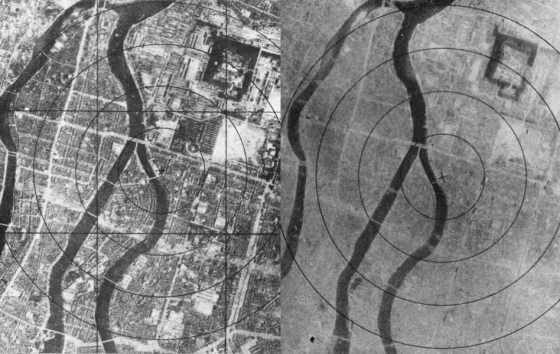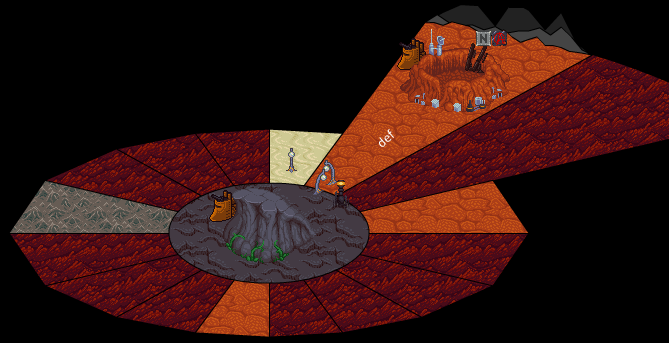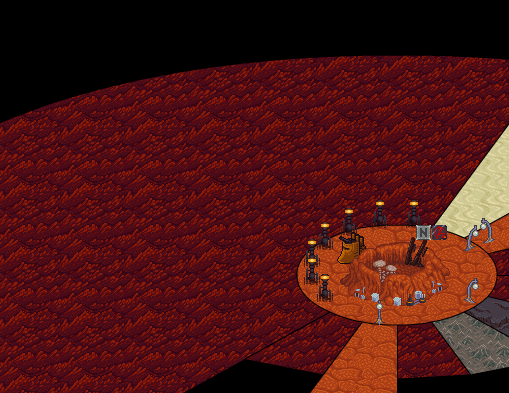
|
< 11 Policy | Index | 13 Trade > 12 Geographica Battleminia The world of Battle Mines is very different to our own, but with many recognizable elements. Aftermath landscapes of global thermonuclear war, burnt down to their basest matter before ashes blew away, colour-coded to show the type of mineral they contain. Divided into tectonic packets, each dominated by a different empire, all sit restlessly in the immense Sea of Rust.
The world of Battle Mines is very different to our own, but with many recognizable elements. Aftermath landscapes of global thermonuclear war, burnt down to their basest matter before ashes blew away, colour-coded to show the type of mineral they contain. Divided into tectonic packets, each dominated by a different empire, all sit restlessly in the immense Sea of Rust.
Lording over the lands are the battle mines themselves, their fiercely proud people safe within. The citizens of Battle Minia eke out a living assisted by their protective behemoth, tilling and drilling the land to build a civilization. Each land contains just one type of resource for the inhabiting miners, and a battle mine cannot reap the spoils of lands outside its area of influence. This is why relationships with other battle miners are so important. The map configurations are generated by tectonic forces beyond comprehension. Your land could be pushed along on a round trip world tour, with little you can do about it. Don't worry, it's just Battle Mines being alive. 12.1 OutpostsEverything discussed so far has been concerned with managing operations within your own borders. Outposts are your gateway to the world beyond that protective boundary, where your neighbours and the real fame and fortune lie.Visible on the map screen, your empire presides over a chunk of land at the centre of sixteen others, resembling the spokes of a wheel. Before the advent of outposts, the spokes are shortened, with most of the external territory cloaked in mystery. All that can be made out is whether it is land or sea, and if land, the base resource of that territory.
In order to meaningfully interact with these hidden regions outposts, or OPs, are built at the outskirts of your land. These glass towers reveal the wheel spokes, shedding light and vision on regions beyond. You will be notified when a neighbour builds an outpost to see your land. If you build an outpost on a Sea of Rust tile, this is known as a lighthouse and you get fishing and irrigation benefits to your growth modifier. 
Outposts usually cost one glass. If you are building on land and the other empire has a government that hates yours, the cost will instead be two glass (you will be warned). When a player is brand new to the game, others are given a free outpost on them. Outposts are destroyed on the outbreak of hostilities, when patches of land are changing hands or jostling about, and when other earth-shattering forces are at play. Remember, OPs are a link between the lands of two neighbours, but they only go one way, so they often come in pairs.
Having no outpost but a spy on a neighbour affords map visibility and direct access to that player's profile, but does not afford the other benefits of an outpost. If a master and vassal are neighbours they can see each other on the map, even in the absence of outposts. The red horseman affords visibility to all neighbours regardless of other factors. 12.2 NeighboursNaturally, all this curiosity about the lands beyond your own is reciprocal, your neighbours are just as anxious for updates on your activities.Besides letting you see who's out there, outposts open up three main avenues of interaction: Trade, espionage, and warfare. Whoever builds the first outpost will have the ability to freely exercise all these operations on the outposted neighbour, so posting trades is always worthwhile. An action made by your neighbour reveals who they are, unless that action would not normally jeopardize their anonymity, such as in a successful sabotage attempt. Even though you know the perpetrator, you may still be unable to see them on the map until you OP them. Neighbours can spread excess pollution and radioactive fallout into your land whether you outpost them or not. 12.3 The Sea of RustThe Sea of Rust has been devouring old cannons and vintage school buses since time immemorial. Its culinary bounty of iron-oxide rich delights including kelp, giant squid, and heterodontic bivalves have sustained many a generation of battle miners, yet its mysteries go far beyond what sort of fish you should have with your chips.
An outpost built on a Sea of Rust tile, known as a lighthouse, adds a +1 growth modifier when the weather is not rainy or stormy. Lighthouses act as outposts in every other way, turning into them when lands come and go naturally. 12.4 TectonicsThe land dominated by each battle mine is a surprisingly malleable entity. It can be terraformed, exchanged, and even go sailing through the Sea of Rust on a wave of tectonic shift.Players have only indirect control over which players are present on their map. Friends are likely, though not guaranteed, to show up more often than random players. Idle players will generally find themselves surrounded by other idles, until they choose to start playing again, at which point the process will reverse. Doomsday devices tend to attract very high scoring players for some reason. The exact mechanics of tectonic shift are subtle, and arcanely buried in the underlying structure of Battle Minia. If you are in a hurry to get someone off your map, there is one option. See Land Push for details. 12.5 HeftHeft is the absolute difference in weight between your land and a given neighbourís, plus one. If your land is heavily developed and your neighbour's is relatively spartan, or vice versa, their land will have a large heft. If your levels of megaconstruction are roughly equal, heft is reduced. See Land Weight to understand where these values come from.The maximum value of heft is 10. Heft determines the cost of land push. 12.5.1 Land PushAnnoying neighbours got you down? No problem, just give them a gentle nudge of appreciation!Land push is the act of using a controlled nuclear explosion to push a given neighbourís land away from your map, sending them cruising through the Sea of Rust. The cost of doing this is determined by heft, which is determined by land weight. This means if your neighbour has a lot more or a lot less stuff than you, they will be more difficult to dispatch. Be warned, both lands may experience some fallout.
So, for example, if you were to attempt land push from your empty land on a neighbour with a completed doomsday device, the heft would be at least 20 (+1 land weight/DM chunk):
When you perform a land push, outposts on both sides are destroyed. Land push is achieved through the player profile. The target neighbour must be visible on the map. Note that if either player has dispatched a diplomat to the other, land push is prevented. Enriched uranium-heavy local combat can trigger an effect similar to land push. < 11 Policy | Index | 13 Trade > |
